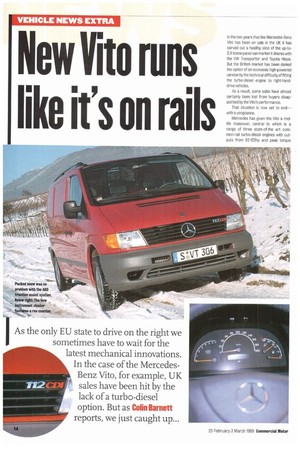New Vito runs like it's on rails
Page 16

Page 17

If you've noticed an error in this article please click here to report it so we can fix it.
In the two years that the Mercedes-Benz Vito has been on sale in the UK it has carved out a healthy slice of the up-to2.8-tonne panel van market it shares with the VW Transporter and Toyota Hiace. But the British market has been denied the option of an economic high-powered version by the technical difficulty of fitting the turbo-diesel engine to right-handdrive vehicles.
As a result, some sales have almost certainly been lost from buyers disappointed by the Vito's performance.
That situation is now set to end— with a vengeance.
Mercedes has given the Vito a midlife makeover, central to which is a range of three state-of-the art common-rail turbo-diesel engines with outputs from 82-122hp and peak torque ranging from 200-300Nrn. The fourvalves-per-cylinder DOHC englnes feature electronically managed directi election from a high-pressure common rail; the 102 and 122hp versions are charge-cooled.
The new CDI engines include a fuel pre-heating system for improved efficiency during cold weather., while a CAN databus links all the vehicle's electronics and facilitates maintenance. We have not been able to carry out fuel consumption testing yet, but Mercedes claims an improvement of 10-15%. A 130hp petrol engine, similar to that fitted to the previous model, is offered, but is not expected to be a significant seller.
On the mechanical front, other changes include an all-new gearbox featuring revised ratios and quieter and more efficient gears. A new hydraulically operated self-adjusting 240mm clutch is fitted to a dual-mass flywheel. A revised automatic gearbox, with semi-intelligent "dynamic shift programming", is available on all but the 82hp model.
Engine oil change service intervals have been extended to 14,000 miles (22,500km) or every two years on all models, while gearbox oil change intervals have doubled to 56,000 miles (90,000km). ABS and ABD (traction assistance) are standard on the 112 CDI and the 113.
UK Vitos benefit from side-loading doors on both sides, and a choice of tailgate or double side-hinged rear door. in either case, the doors are glazed with rear wipers as standard, with a lowercost unglazed option. Inside, a ladderframe bulkhead is standard with glazed or solid full bulkheads as options.
In the cabin, the dashboard is made of a new, better quality plastic and the seats have a new cloth trim. The seats sit on runners with an extra 20mm of travel. A new instrument cluster, with a revcounter on all models, is fitted along with redesigned centre console switchgear and a leatherette trim for the dashmounted gear lever. A radio/cassette player comes as standard.
Driving impressions
CM sampled all the diesel-powered Vitos in turn; they each carried around 250kg of ballast. First was the 122hp 112 COI with its magnificent 300Nm of torque. Its performance, as you might expect, is more than adequate.
If needed it will pull from 800rpm in top and keep going all the way to the magistrate's court. Top speed, which is unlimited for vans up to 2.8 tonnes on the autobahns of its homeland, is well in excess of 100mph.
It's obviously built to be safe at those speeds, so it's no surprise that manners at more realistic rates are impeccable. Handling is extremely stable, whether cruising on motorways or negotiating the many snowy hairpins we encountered near to the launch base south of Strasbourg.
Ride, despite some pretty indifferent surfaces, was always well controlled and comfortable, A brief excursion onto a side road with a surface of packed, frozen snow proved the efficacy of the ABD traction assist system.
The whole driving package of the updated Vito has benefited from the extra smoothness given by the new engines. The only downside with the top-of-therange model was that there was more engine noise when under load than expected. Mercedes engineers say there iS still the possibility of fine tuning the pilot 'ejection settings for production vehicles, which should help. In all other situations the mechanical noise levels are impressively low, and the Vito feels as solid and rattle free as we expected from a Mercedes-Benz.
Next to be tried was the 110 CD! which, with its 102hp/250Nm, is probably the best all-round bet. It costs £1,400 less than the 112 CD!, but loses that model's standard ABS and ABD. It still has ample reserves of power for most needs and felt more relaxing to drive. The engine's "knock' under load was much less apparent and it generally felt a bit sweeter.
Despite a similar power output to the old Vito diesel, the basic 108 CDI is worlds away in terms of driveatality and refinement.
But although its performance is much better than the outgoing model's, the extra grunt of the 110 CDI, at a cost premium ofjust £900, means it is likely to be the most appealing model for everyday operations.
















































































































